Barbara Klessig:
A Conversation with a Laurel
By Cathy Koos
(all photos courtesy of Barbara Klessig)
Through the wonders of Zoom, I recently had the distinct pleasure of chatting with Northern California textile archaeologist Barbara Klessig. We had a broad-ranging chat about all things prehistoric.
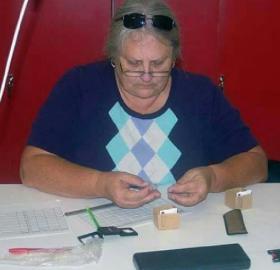
Barbara gathering data at the State Historical Museum, Stockholm
Barb came to archaeology later in her life, earning her Bachelor of Art in anthropology at Humboldt State University in 2007, at the age of fifty-three, followed by her Master of Arts in Social Sciences at Humboldt at 61. She has stayed at her alma mater (now Cal Poly Humboldt) to teach during the academic year and conduct field research each summer.
In addition to her research and academic work, Barbara is also a member of EXARC, an international experimental archaeology organization. she is also a Master Laurel of Textiles in SCA (Society for Creative Anachronism) and recently participated in the Penthic War reenactment at SCA’s 50th anniversary in Slippery Rock, PA.
Among her many interests, the archaeology of gender, women, and community, environmental, and landscape archaeology are prominent.
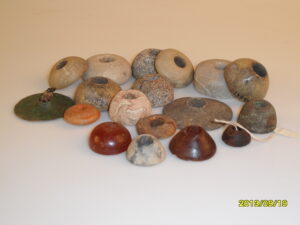
A collection of spindle whorls Barbara recorded for her master’s thesis of stone, bronze, bone, amber.
Barbara started out as a basket weaver when living in the Bay Area. She moved to loom weaving a few years later. She recently picked up drop spindling, as wheel spinning did not suit her. The drop spindle is really her forte now, producing flax singles as fine as sewing thread.
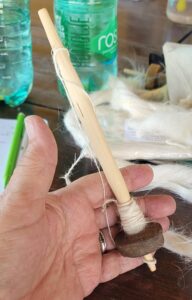
Barbara spinning hemp with a 2000-year-old spindle whorl
As an experimental and experiential archaeologist, Barbara takes an ancient textile scrap, examines it, and then works backwards to determine how it was made and used. These processes show technological advances over millennia. In this same way with found loom weights, she has developed warp weighted looms – just from studying the loom weight. And the same with found spindle whorls. She will create a copy of the weight or whorl and then experiment until she produces satisfactory results.
Barbara’s primary focus is textile archaeology in the British Isles, Scandinavia, and Macedonia, the latter being her destination the last two summers. In Macedonia last year, Barbara made an exciting discovery of pre-Roman looms.
Barbara has also spent quite a bit of time excavating on the island of Gotland in the Baltic Sea near Sweden. “Gotland is smack dab in the middle of the Baltic and for the Vikings it made a perfect trading center,” Barbara said. There is not a really reliable source of fine metals nor silicon in Scandinavia, so trade was important in the manufacture of jewelry, weapons, even horse tack. Every silica deposit in the world has its own chemical signature. By studying the chemical composition of glass artifacts found in Gotland, researchers glean that most of the excavated glass comes from Italy.
With loom tablets excavated in Gotland, Baarbara discovered they were not made of wood, but in fact, were made from moose antlers! These tablets would have been between 3 and 5 cm square (about 2 inches). While she has not recovered antler tablets in the amount expected for larger textile pieces, she has not been to every site. The same goes for loom weights – few and far between. Barbara plans to acquire some contemporary moose antlers and recreate some tablets.
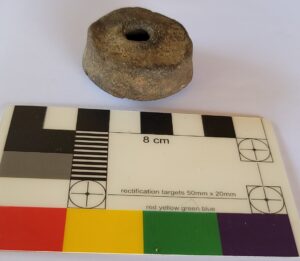
2000-year-old clay spindle whorl from Macedonia, current research
Barbara has also found that during the Viking Age, Gotlanders were raising their namesake double-coated sheep. It is possible that they traded out raw wool to someone outside of Gotland in exchange for high quality metals and textiles they could not produce on their island. This hypothesis is reinforced by the fact that some luxury goods and band-woven trim excavated from burial sites have been found with fine silk and gold threads. Also found in these burial sites were weaving tools, tablets, and whorls. It is assumed that the majority of the graves with theses tools belonged to women, but it is quite likely that occasionally men could have been weavers, too.
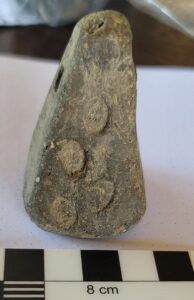
Loom weight with ring impressions of Athena, patron goddess of weavers, current research in Macedonia
After the academic year is over, Barbara plans to travel to Macedonia again, analyzing and recording not just textiles, but pottery and other artifacts. She also has a professional paper in the works for an academic journal.
You can learn more about Barbara here:
https://anthopology.humboldt.edu/people/barbara-klessig
EXARC here:
Birka and Gotland:
Macedonia:
https://whc.unesco.org/en/list/99/
https://www.historyhit.com/guides/historic-sites-in-north-macedonia/